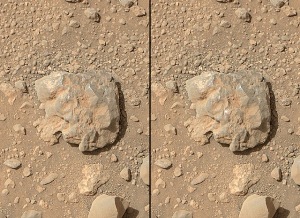Jul 17 2014
Flashes appear on a baseball-size Martian rock in a series of images taken Saturday, July 12 by the Mars Hand Lens Imager (MAHLI) camera on the arm of NASA's Curiosity Mars Rover. The flashes occurred while the rover's Chemistry and Camera (ChemCam) instrument fired multiple laser shots to investigate the rock's composition.
 NASA's Curiosity Mars rover used the Mars Hand Lens Imager (MAHLI) camera on its arm to catch the first images of sparks produced by the rover's laser being shot at a rock on Mars. Credit: NASA/JPL-Caltech/MSSS
NASA's Curiosity Mars rover used the Mars Hand Lens Imager (MAHLI) camera on its arm to catch the first images of sparks produced by the rover's laser being shot at a rock on Mars. Credit: NASA/JPL-Caltech/MSSS
The images, strung together as a video, are available online at: http://www.jpl.nasa.gov/video/?id=1317
ChemCam's laser has zapped more than 600 rock and soil targets on Mars since Curiosity landed in the planet's Gale Crater in August 2012.
"This is so exciting! The ChemCam laser has fired more than 150,000 times on Mars, but this is the first time we see the plasma plume that is created," said ChemCam Deputy Principal Investigator Sylvestre Maurice, at the Research Institute in Astrophysics and Planetology, of France's National Center for Scientific Research and the University of Toulouse, France. "Each time the laser hits a target, the plasma light is caught and analyzed by ChemCam's spectrometers. What the new images add is confirmation that the size and shape of the spark are what we anticipated under Martian conditions."
Preliminary analysis of the ChemCam spectra from this target rock, appropriately named "Nova," indicates a composition rich in silicon, aluminum and sodium, beneath a dust layer poor in those elements. This is typical of rocks that Curiosity is encountering on its way toward Mount Sharp.
MAHLI Deputy Principal Investigator Aileen Yingst of the Planetary Science Institute, Tucson, Arizona, said, "One of the reasons we took these images is that they allow the ChemCam folks to compare the plume to those they imaged on Earth. Also, MAHLI has captured images of other activities of Curiosity, for documentation purposes, and this was an opportunity to document the laser in action."
Malin Space Science Systems, San Diego, developed, built and operates MAHLI. The U.S. Department of Energy's Los Alamos National Laboratory, in Los Alamos, New Mexico, developed ChemCam in partnership with scientists and engineers funded by the French national space agency (CNES), the University of Toulouse and France's National Center for Scientific Research.
NASA's Mars Science Laboratory Project is using Curiosity to assess ancient habitable environments and major changes in Martian environmental conditions. NASA's Jet Propulsion Laboratory, a division of the California Institute of Technology, Pasadena, built the rover and manages the project for NASA's Science Mission Directorate in Washington.
For more information about Curiosity, visit these sites: http://www.jpl.nasa.gov/msl , http://www.nasa.gov/msl and http://mars.jpl.nasa.gov/msl/
You can follow the mission on Facebook at: https://www.facebook.com/marscuriosity and on Twitter at: http://www.twitter.com/marscuriosity
Source: http://www.jpl.nasa.gov/